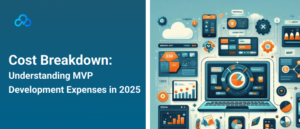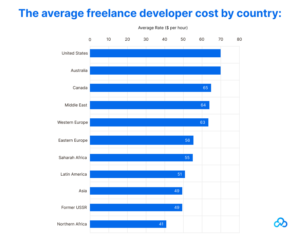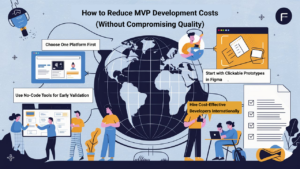Cost Breakdown: Understanding MVP Development Expenses in 2025

Whether you’re starting a business or launching a new product concept in 2025, most startup founders have heard of MVP development but often remain unclear about the key cost factors and budgeting requirements.
This article addresses both technical experts and non-technical founders by explaining all fundamental elements that determine the expenses of creating Minimum Viable Products in current market terms. At the conclusion, you will understand financial expectations along with practical methods to dodge typical money drains during the development process.
Let’s dive into it.
What is MVP and Why Does It Matter?
Understanding the definition of an MVP demands an examination first. MVP stands for Minimum Viable Product. An MVP represents a basic product version having essential features that solve customer problems and enable you to collect user feedback. The main objective consists of rapid construction followed by initial examinations that prevent both financial waste and the development of features that fail to attract users.
Customers will find your MVP to be the scaled-down version of your final product, yet powerful enough to win early users along with investor interest.
The Real Cost of Building an MVP in 2025

The key question today focuses on the expenses required to build a Product MVP in 2025.
The truth is, it depends. Companies investing in MVP development require budgets between $10,000 to $150,000 based upon multiple essential project characteristics. The amount required to develop a Product Minimum Viable Product depends on whether your product requires only basic mobile features or advanced SaaS capabilities, including backend features and user permissions. Your budget will face major impacts through every organizational decision made. The final cost ranges from $10,000 to more than $150,000, and this variation depends greatly on the combination of selected tools and frameworks alongside custom code or no-code platforms.
1. MVP Scope and Feature Set
The initial and most critical expense variable emerges from determining the extent of your minimum viable product. A fundamental evaluation of your product requires determining whether it includes a basic landing page for subscriber email registration or a complete mobile application with user profile functions and billing connectivity.
Here’s a rough breakdown:
- Conducting MVP development for a landing page with user sign-ups and basic backend operations costs between $10,000 and $25,000.
- Moderate MVP (Web/mobile app with user logins, CRUD operations, notifications): $25,000–$75,000
- The development of multiple user roles and advanced integration with AI features requires funding between $75,000 and $150,000+ to achieve.
Since building extensively in this area is simple, you should develop a ruthless selection process. Focus only on delivering your key value propositions, which demonstrate why your product needs to perform well.
2. Team Structure and Development Approach
Who builds your MVP also has a huge impact on cost.
Here are your main options in 2025:
The least expensive option for staffing projects is hiring freelancers, although this approach includes various potential dangers. You will have to hire different teams for designing and developing, in addition to performing quality assurance checks. The pricing for freelancers starts at $25 per hour and tops out at $150 per hour when dealing with U.S./Western European developers. Planning small projects with multiple freelancers as an affordable choice initially still needs constant supervision from your end to manage overhead expenses.
In-House Team – Great for long-term vision, but expensive upfront. Expenses related to salary costs, together with benefits and overhead, rapidly increase. The lengthy process of team recruitment makes hiring an unfavorable choice for swift MVP development unless you already have staff available.
Development Agencies – A balanced option. Major agencies facilitate complete MVP development through combined design and software development services with quality assurance and project management capabilities. Rates vary by region:
- Eastern Europe/Latin America: $40–$70/hr
- North America/Western Europe: $100–$200/hr
The additional cost you pay at this stage provides you with enhanced speed alongside structured organization and reliable practices.
No-Code/Low-Code Platforms – Perfect for MVPs with limited logic or internal tools. The combination of Bubble and Softr, and Glide tools reduces development expenses to between $5,000 and $20,000. These solutions help individual entrepreneurs check their concepts before building bigger tech teams.
An organization’s choice between agency employment and freelance work creates a balancing act between delivery speed and project quality as well as cost efficiency. Agencies increase project costs yet provide risk reduction and deliver projects at a quicker pace and with lower problem occurrence.
3. Design and User Experience (UX/UI)
Always maintain respect for the force of superb design because users evaluate products within their initial few seconds. Your product receives its first user impressions during the first several seconds of interaction.
Project design expenses for minimal viable products have diverse price ranges depending on the specific requirements.
- Wireframes & UX flow: $1,000–$5,000
- UI Design (custom screens, branding): $2,000–$10,000
- Design systems & responsiveness: Add $2,000–$5,000
Your MVP must provide excellent UX if it faces customer interactions. The adoption and credibility of products increase when they have clean designs.
Design system templates and UI kits help organizations save money on product quality while decreasing their expenses.
4. Technology Stack and Infrastructure
The choice of tools together with technologies affects how much an MVP development costs. Your product needs and scalability demands and developer qualification levels determine the stack selection process.
Typical options in 2025 include:
- Frontend: React, Vue, Flutter (for cross-platform apps)
- Backend: Node.js, Django, Ruby on Rails
- Database: PostgreSQL, MongoDB, Firebase
- The three main cloud hosting solutions you will encounter are AWS, Google Cloud, and Vercel.
Side costs for facilitating infrastructure remain low during the development stage when you create your MVP.
- Cloud hosting & storage: $50–$500/month
- APIs & third-party tools: $20–$300/month
Begin with modest plans that you can expand according to user expansion.
5. Features That Drive Up Costs
Flawed MVP development features may trigger your cost to increase dramatically. Be careful with:
- Real-time messaging or chat
- AI or machine learning integrations
- Video or audio streaming
- Complex admin dashboards
- Custom analytics or reporting
- Blockchain or crypto wallets
Advanced features require expert knowledge as well as longer development time until they become fully tested. After your product launch, your infrastructure together with hosting expenses, will become more expensive due to these additional features. Features such as these should be dropped either from your initial MVP release or scheduled for a later development phase because they don’t match core MVP essentials. Your solution can benefit from third-party connections to simplify development processes, such as Sendbird for chat and Twilio for video and Stripe for payments.
6. QA, Testing, and Maintenance
A software MVP becomes truly happy when it is free from all bugs. Quality Assurance (QA) stands as a crucial aspect which people frequently dismiss. An errorless smooth user journey remains the determining factor between retained users and one-time visitors.
Typical QA and maintenance costs:
- Manual testing: $1,000–$5,000
- Automated testing setup: $2,000–$10,000
- The total development expense requires 10-20 percent of its value to maintain the application through regular updates and bug fixes annually.
Integrate quality assurance measures from the beginning because hasty bug fixes after launch will cost more. A minor bug which looks insignificant might result in the loss of important early adopters. After your product launches you will need to dedicate additional funds for updates that stem from user feedback. MVP development requires continuous improvement and product enhancement as part of its evolutionary process.
7. Hidden and Unexpected Costs
Other than development costs, there exist numerous concealed expenses which entrepreneurial leaders frequently overlook during their budgeting process:
- The project management company provides several digital platforms, including Jira, Trello, and Slack.
- Domain & SSL certificates
- Legal fees (terms of service, privacy policies)
- Marketing & landing pages
- Analytics tools (Mixpanel, Hotjar, GA4)
It is essential to keep 10-20% extra funds for managing unexpected events.

How to Reduce MVP Development Costs (Without Compromising Quality)
Bootstrappers who need to decrease MVP development costs should try these effective methods to reduce expenses:
- Start development with one platform selection between web and mobile because dual-platform development should only occur when essential.
- During the early stages of validation, you can use no-code tools such as Bubble and Glide as well as Webflow.
- The funding-efficient way to begin development starts with clickable prototypes that Figma can create affordably for a reduced budget.
- Professional developers located in Eastern European, Asian, and Latin American areas should be hired to tackle development costs efficiently.
- Your project should have a concrete MVP definition to prevent extended features. Record down your MVP definition alongside a list of features that should stay out of the first version.
MVP Cost by Industry in 2025
Complex MVPs are standard among certain industries for their operations. Here’s a rough comparison:
- Social Media App MVP: $40,000–$120,000
- E-commerce MVP: $25,000–$75,000
- Fintech MVP: $60,000–$150,000+
- SaaS Tool MVP: $30,000–$80,000
Again, these are broad estimates. Your distinct features, together with project aim,s will determine the final budget expenses.
The ROI of a Well-Built MVP
You should avoid cutting costs when developing your MVP because it stands as the fundamental base for your product. The initial user encounter relies on your MVP because it establishes the fundamental aspects that will nourish upcoming product developments. A well-executed MVP can:
- Validate your market fit
- Impress investors
- Attract early adopters
- The early full launch success depends on how well you stage this step
Lean operations should not lead to negligence in any tasks. A feeble and unstable MVP launch will erode your business concept before your product becomes operational. Cut unessential elements from your product only if they do not harm the basic product functions or accessibility or user experience. When developing your MVP you should view it as your fundamental startup message to potential investors. Make it count.
FAQ
1: What is an MVP in software development?
The simplest version of a product that contains essential basic features for addressing specific problems while offering worth to early users is termed an MVP. The main purpose of developing an MVP involves fast validation testing of the product concept as well as obtaining user opinions to determine product development directions. The creation of Minimum Viable Products shortens the development period, along with helping prevent investing in unnecessary features.
2. How much does MVP development cost in 2025?
An MVP’s development cost in 2025 falls between $10,000 and $150,000 based on product complexity as well as selected features and hired team composition. To build a basic MVP you need less funds when using no-code tools with offshore teams but advanced MVPs requiring custom features and AI components need higher funding.
3. What features should be included in a Product MVP?
A minimum viable product, should have all its necessary features to display its core value proposition. Such products contain fundamental features along with essential workflows that solve multiple user challenges while allowing them to register. Anything that is not necessary for proving your concept needs to be postponed until subsequent iterations.
4. Can I build an MVP without a technical background?
Yes! The year 2025 presents non-technical founders with an exceptional number of tools for building and deploying MVPs. The no-code platform ecosystem includes Bubble and Webflow, and Glide, which let users construct operational products by avoiding programming altogether.
Final Thoughts: Planning Your MVP Budget Wisely
Strategic planning determines the total cost of constructing an MVP development in 2025. The main business objective lies beyond seeking minimal costs. You should apply enough financial resources to gain a rapid understanding while efficiently updating alongside keeping unnecessary solutions at bay.
The following points serve as a handy way to budget wisely:
- Your MVP requires an exact definition that remains crystal clear
- The most important development phase involves selecting essential features that support your value proposition.
- Select an appropriate development team and model
- Future development should account for unexpected expenses as well as continuing costs
- Development tools and templates help businesses speed up their development process.
The main purpose of your minimum viable product serves as a learning platform rather than delivering a finished product. Setting your startup up for strong market engagement will become possible by building carefully and conducting early tests to guide rapid adjustments that avoid budget overruns.
Do you like to read more educational content? Read our blogs at Cloudastra Technologies or contact us for business enquiry at Cloudastra Contact Us.